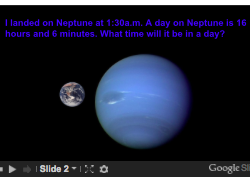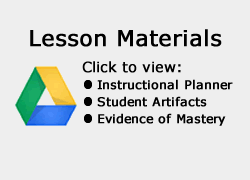This lesson is for : Grade 4:
Summary
Figuring out elapsed time can be a matter of life and death, especially for an astronaut who has a limited supply of oxygen. Thankfully, in fourth grade we study the planets (Science SOL4.7) and elapsed time (Math SOL4.9), so we have the skills we need to solve this problem: “You are an astronaut. You have been given the incredible opportunity to explore a planet of your choice. But you only have enough oxygen to last one complete day on the planet. How will you calculate what time you must leave the planet?” The first step in solving the problem is to observe the planets in motion and select one that interests us. We will use an animated 3-D view of the solar system to help us make our decision http://www.solarsystemscope.com/ Once we select our planet, we discuss what factors determine the length of a day on the planet, and we conduct research to find out long a day lasts on our planet. Next we create a word problem using Google slides and images. We provide the length of day and the time we arrive, and our classmates must figure out what time we must leave the planet. We post our slideshows to Google classroom for everyone to view, and they post their answers in the comments section. Can you save the astronauts? Try some here.
TIPC Ratings
Research & Information Fluency
Rating: Approaching – Explanation: Students selected their own planet and their own way for finding out the length of day on the planet (books, posters in class, or an Internet search were all options). We guided them on efficient ways to search but ultimately they could do it anyway they wanted. They did not come up with their own research question, but they did take their research and turn it into a unique and authentic problem for their classmates to solve.
Communication & Collaboration
Rating: Approaching – Explanation: Students worked individually on the research and slideshow creation since a goal of this lesson was to teach them how to make Google slideshows (something they had never done before). However, they collaborated and communicated during the problem solving process since the problems were posted to our Google classroom page, and multiple students tried to solve each other’s problems in the comments section under each slideshow. They could also choose the classmates with whom they wanted to collaborate.
Critical Thinking & Problem Solving
Rating: Approaching – Explanation: Students generated and solved their own elapsed time word problems. Students could make their problems harder or easier to solve by adjusting the start time (for example, 12:00 am would be an easy start time, but 9:15 pm would be a more difficult start time). They were solving an authentic task of calculating the time an astronaut would have to leave the planet given a limited amount of oxygen. They used digital tools to research, create, display, and solve their problem.
Creativity & Innovation
Rating: Developing – Explanation: Students combined their mathematical knowledge (of elapsed time) and scientific knowledge (of the planets) into an original problem they created. They chose how to display their problem using the fonts, colors, images, and transitions that they wanted to use. Although they were limited by the requirement of using Google slides, since this was their first time using it, they were given creative freedom within the scope of using that tool.






